 |
|
Here and There introduces art, artists, galleries and museums around Japan that non-Japanese readers and first-time visitors may find of particular interest. The writer claims no art expertise, just a subjective viewpoint acquired over many years' residence in Japan.
|
|
 |
|
|
 |
 |
Tokaido Highway Revisited: Hiroshige's 53 Stations at the MOA Museum
Alan Gleason |
 |
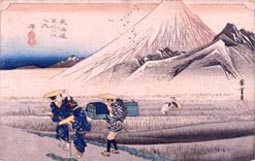 |
|
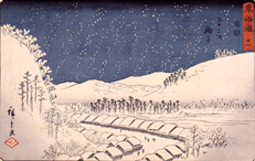 |
| Hiroshige's depictions of Hara, the 13th of the 53 post stations between Edo and Kyoto on the Tokaido highway, and Mariko, the 20th. Hara is from the Hoeido edition (ca. 1833-34) and Mariko from the Reisho edition (ca. 1848-54) of the series. Collection of the MOA Museum of Art |
The renowned woodcut series Fifty-Three Stations of the Tokaido is justifiably hailed as the high-water mark of the career of Utagawa Hiroshige (1797-1858), and of landscape ukiyo-e in general. Less well known is the fact that he revisited the series dozens of times, producing as many as 30 versions in response to popular demand. Few of these were completed to cover the entire 55 (yes, 55) scenes of the original, however, and many of the later versions betray a somewhat simplified, even slapdash approach. The first edition, named the Hoeido after its publishers, remains the standard. This is the version of the Fifty-Three Stations that made Hiroshige famous virtually overnight, and that has been seen around the world.
As a fan but not a terribly knowledgeable one, I was dimly aware that there were other versions of the series, but had never had the chance to see these alternate renderings, so the Hoeido scenes were the ones permanently etched in my head. Fifty-Three Post-Stations of the Tokaido Series, an exhibition that is up until January 30 at the MOA Museum of Art in Atami, offered an opportunity to see other series besides the Hoeido and even compare them with one another, so off I went.
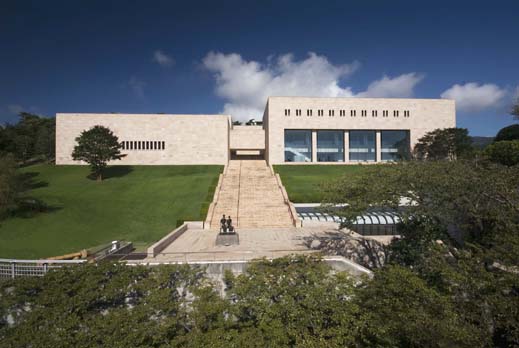 |
| Looking uphill toward the MOA Museum of Art, Atami, completed in 1982. |
Atami is a rusty old hot springs resort that has seen better days, but its location is still to die for, situated as it is on the steep hills rising from a semicircular volcanic bay on the Izu Peninsula. Less than an hour from downtown Tokyo by bullet train, it's an easy day's excursion from the capital. And the MOA itself is perched right at the top of the hill, with sweeping vistas of the sea below. Founded by Mokichi Okada (1882-1955), a spiritual teacher who was also an aspiring artist, avid art collector, and firm believer that art "elevates human sentiments and contributes toward cultural development," the museum moved to this sublime location in 1982. A sturdy contemporary structure of Indian sandstone and glass (plenty of big windows from which to enjoy the view), it houses a collection of some 3,500 works, primarily of traditional East Asian art.
For the Hiroshige show the MOA has delved into its own collection, displaying not only a complete set, in pristine condition, of the Hoeido edition, but large portions of two other complete editions that are generally regarded as the next-best of Hiroshige's Tokaido series, the Gyosho and Reisho. The Hoeido was produced in 1833 and 1834, the Gyosho around 1842, and the Reisho between 1848 and 1854. The latter two names refer to the styles of calligraphy with which the titles were written on each cut. Most of the works in the MOA collection are from the first imprints of these editions, but not all; as a curator explained to me, first printings are hard to come by and sometimes difficult to distinguish from later printings off the same blocks. Woodblock printing is, after all, a mass-production technique.
 |
 |
 |
From the top, the Hoeido, Gyosho, and Reisho versions of Hakone, by Utagawa Hiroshige. Collection of the MOA Museum of Art
|
In one of several galleries the curators have graciously arranged different renderings of the same Tokaido "station" from these three editions side by side for ready comparison. Hiroshige rarely repeated the same scene twice, so where the iconic Hoeido view of Hakone offers a grand panorama of lake and cliff, the Gyosho and Reisho both focus on a palanquin procession struggling over Hakone Pass -- but the former is shown by day, the latter by night, and the surrounding landscapes are dramatically different.
Other celebrated motifs -- the snow at Kanbara, the slanting rain at Shono -- appear only in the Hoeido edition. (The Gyosho and Reisho versions of Kanbara are snowless, and since it rarely if ever snows in Kanbara, there is some doubt whether Hiroshige actually encountered any of the white stuff there.) There are only a few snow scenes throughout these series; the Reisho edition's Mariko and the Gyosho's Ishiyakushi are two other lovely specimens on display here.
There are many masterpieces among the Gyosho and Reisho prints, but when you examine them next to the Hoeido edition, it's obvious why the Hoeido is so revered. Imaginative compositions, exquisite details, impeccably rendered lines -- it has it all. The Gyosho and Reisho suffer by contrast; with rare exceptions the images appear to be simpler, even coarser, the human figures crossing the subtle line from realism to caricature -- perhaps to make the prints quicker to churn out? There is the suspicion, too, that overwhelmed by demand, Hiroshige increasingly relied on his disciples to produce these later works.
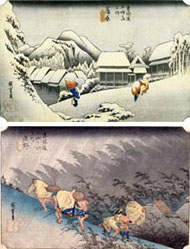  |
The famous scenes of Kanbara in the snow and Shono in the rain, both from the Hoeido edition. Collection of the MOA Museum of Art
|
|
|
But there is no question that the artist poured his soul, and his entire arsenal of techniques, into his first opus, the Hoeido. At the time Hiroshige was already beginning to earn recognition for his talents as an ukiyo-e artist, particularly of landscapes, but he had not yet made his mark. He took his first journey down the Tokaido highway in 1832 as part of a procession accompanying a gift of horses from the Shogun in Edo to the Emperor in Kyoto. Though there were 53 post stations along the way where travelers could stop for the night, most made the 500-kilometer trip in around ten days. Hiroshige's retinue presumably took its time, allowing the artist to make numerous sketches of every station along the way. A year later, he was the toast of Edo.
The next exhibition at the MOA showcases Red and White Plum Blossoms, a national treasure by the Rinpa master Ogata Korin, as well as works by other Rinpa-school artists. The show runs from 1 February to 20 March 2013.
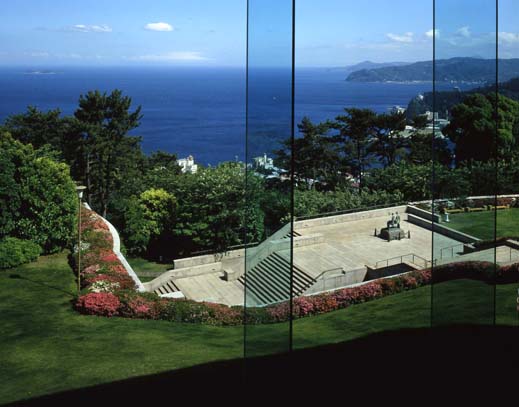 |
The view of Atami Bay from the main lobby of the MOA Museum of Art.
All images courtesy of the MOA Museum of Art |
|
|

|
Fifty-Three Post-Stations of the Tokaido Series |
 |
MOA Museum of Art |
 |
1 - 30 January 2013 |
 |
26-2 Momoyama-cho, Atami City, Shizuoka Prefecture
Phone: 0557-84-2511
Hours: 9:30 a.m. to 4:30 p.m. (admission until 4 p.m.); closed Thursday (except when a national holiday), December 25-31, and January 4-10
Transportation: 7 minutes by bus from Atami station on the JR Tokaido and Tokaido Shinkansen lines. Atami is 50 minutes by Shinkansen bullet train from Tokyo. |
 |
|
 |
|
|
|
|
 |
Alan Gleason
Alan Gleason is a translator, editor and writer based in Tokyo, where he has lived for 25 years. In addition to writing about the Japanese art scene he has edited and translated works on Japanese theater (from kabuki to the avant-garde) and music (both traditional and contemporary). |
|
|
|
 |
|